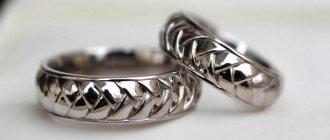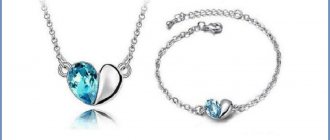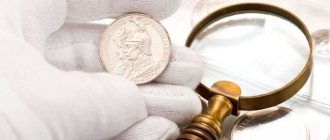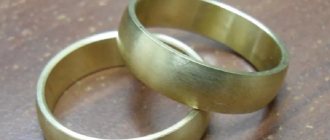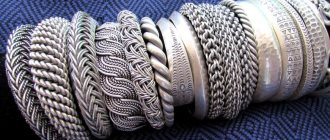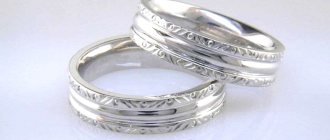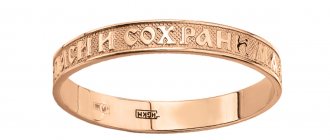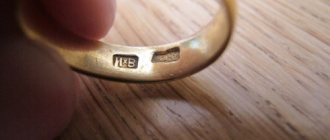Gold and silver are among the most popular jewelry metals. Both of them are used in the form of alloys, since in their pure form they are too soft and ductile. Gold, which is initially yellow in color, becomes white due to the addition of silver, platinum, palladium and nickel. Products made from it are extremely similar to silver. Therefore, the owner of a piece of jewelry often faces the question: is it white gold or cheaper silver?
We tell you how you can distinguish white gold from silver.
How are these metals different?
When choosing jewelry from a particular metal, you need to know that they differ not only in color, but also in some characteristics, cost, and markings.
Composition, strength and weight
White gold is obtained by creating an alloy based on yellow metal and a ligature. The latter includes the following elements:
- platinum;
- silver;
- nickel;
- palladium;
- zinc.
Thanks to the alloy, gold acquires the necessary strength and wear resistance, but at the same time remains quite ductile.
Silver in jewelry is also used in the form of an alloy, to which copper, lead, antimony, oxygen, and bismuth are added. They provide the necessary strength and wear resistance of the alloy. However, if we compare the strength characteristics of precious metals, the advantage will be on the side of gold.
Expert opinion
Vsevolod Kozlovsky
6 years in jewelry making. Knows everything about samples and can identify a fake in 12 seconds
Different densities of metals affect the weight of products. Depending on the composition and standard, the density of white gold is 12.85-16.44 kg/m3, and that of silver is 10.49 kg/m3. Accordingly, a gold ring will be heavier than its silver counterpart, given the same size and shape.
Effect of acidic environment
One of the advantages of white gold over silver is that it is not afraid of acid. That's why one of the most popular ways to test jewelry at home is to dip it in a container of vinegar. If the product contains aurum, it will not change its color.
Silver jewelry will make the liquid cloudy. Because of this reaction, they must be removed before cleaning.
Appearance and markings
White gold has a varnished appearance, while silver metal has a matte finish. With the special lighting available in every jewelry store, the jewelry may shine equally, but when worn, the difference will become more noticeable.
Based on this, in a salon environment, the difference between metals can be determined solely through markings. In the first case, a stamp is placed on the jewelry with the designation of the sample (585 or 750), enclosed in a blade or rectangle. In the second case, the sample (800, 830, 875, 925, 960) fits into the barrel.
Difference between different purity grades
Precious metals have differences not only among themselves. Products made from seemingly the same metal will also have differences depending on the sample. It is determined by the percentage of the main precious metal in the jewelry. Due to the difference in proportions, the density of the alloy, melting point, and hardness change. GOST-approved options based on silver and gold can be seen in the tables below.
Graduation of gold-based alloys:
| Try | Mass fraction of component, % | |||||||
| Gold (Au) | Silver (Ag) | Platinum (Pt) | Palladium (Pd) | Nickel (Ni) | Copper (Cu) | Zinc (Zn) | Cadmium (Cd) | |
| 585 | 58,5 | 25,0 | – | Ost. | – | – | – | – |
| 58,5 | 28,2 | – | 9,5 | – | – | Ost. | – | |
| 58,5 | 27,5 | – | 9,5 | – | – | – | Ost. | |
| 58,5 | – | – | – | 12,0 | Ost. | 3,6 | – | |
| 750 | 75,0 | 14,5 | – | – | 7,0 | – | Ost. | – |
| 75,0 | 14,5 | – | Ost. | – | – | – | – | |
| 75,0 | 8,5 | – | 13,5 | Ost | – | – | – | |
| 75,0 | 6,5 | – | 13,5 | Ost. | – | – | – | |
| 75,0 | 8,5 | – | 8,0 | 3,5 | – | – | Ost. | |
| 75,0 | – | – | – | 7,0 | Ost. | 2,1 | – | |
Graduation of silver-based alloys:
| Try | Compound, % | Impurities, no more than % | |||||
| Silver (Ag) | Copper (Cu) | Lead (Pb) | Iron (Fe) | Antimony (Sb) | Bismuth (Bi) | Oxygen (O) | |
| 800 | 80,0-80,5 | ost. | 0,005 | 0,13 | 0,002 | 0,002 | 0,01 |
| 830 | 83,0-83,5 | ||||||
| 875 | 87,5-88,0 | 0,004 | 0,10 | ||||
| 925 | 92,5-93,0 | ||||||
| 960 | 96,0-96,5 | 0,08 | |||||
Differences in guest standards and quality
The chemical composition, as well as the physical characteristics of white gold and silver alloys are regulated by law. Each product must comply with GOST 30649-99 “Alloys based on precious metals for jewelry.”
Price and demand
The main difference between precious metals, which immediately catches your eye, is the cost of the products. The price of both yellow and white precious metals is much higher for a number of reasons:
- There are fewer gold veins in nature than silver ones;
- complex production technology;
- unique properties of yellow metal.
What stones are suitable
White gold is eye-catching even without inserts. However, bright precious stones make jewelry especially attractive: sapphires, emeralds, diamonds. Also popular are products that harmoniously combine several types of metals, such as white and yellow gold.
Silver jewelry, as a rule, is made with inserts of semi-precious stones and minerals: onyx, iolite, agate, jade, chrysoprase, rauchtopaz, morion. However, occasionally jewelers create collections based on precious inserts, for example with emeralds.
Main features and differences
The cost of these two metals differs significantly. It is difficult to distinguish the product by external signs, and it is not difficult to fall for the tricks of scammers. In order to understand at least a little about these metals, you need to know their properties.
- Color. White gold resembles platinum, which is not surprising. This is exactly what manufacturers achieve when they cover a piece of jewelry with a ligature containing this metal. Silver has a different, darker shade, inherited from nature.
- Shine. Gold has bright shimmers, which is especially noticeable on a flat surface. Silver quickly loses its position and oxidizes, even while on the store shelf. If two pieces of jewelry are viewed simultaneously away from the light of shop windows, you will notice differences.
- Hardness. Silver is a soft metal, so no product is made without additives. However, it is not able to compete with gold in terms of resistance to mechanical stress: when worn, small scratches become noticeable, and with light pressure the shape changes. Gold requires more force to crush it, and scratches are less likely to occur. If you run a metal object over a silver surface, a mark will immediately remain, but with gold the object will simply slide off.
- Sound. When struck against a hard surface, gold sounds loud, and silver sounds dull.
- Exposure to chlorine and iodine. Gold is valuable because it cannot oxidize. Using this property, pawn shop employees check jewelry. Silver undergoes oxidation, and this happens even when in contact with air. For a quick check, use “Whiteness” and a pharmacy tincture of iodine.
It would seem that it is now clear how to distinguish silver from white gold. But rhodium intervened in the production of jewelry.
Rhodium is a natural material used to coat jewelry.
Jewelers began to use it to give strength to silver items. He mixed up all the cards. Silver jewelry coated with rhodium film becomes resistant to oxidation, becomes more durable and acquires the luster characteristic of gold.
It remains to distinguish jewelry only by the mark. Few people will undertake to fake it. Firstly, this is complex and painstaking work, and secondly, it is punishable by criminal penalties.
What is the difference between white gold and silver if the products have been rhodium plated?
If gold jewelry has been rhodium-plated to obtain the desired shade and physical properties, it is impossible to visually distinguish it from silver. In this case, only the mark on the product can help determine the metal used.
If the markings on your existing jewelry are not trustworthy, you can take it for chemical analysis. During the inspection, the metal is tested with acid. The main disadvantage of this method is that a trace of the reagent may remain on the product.
Which product should you choose - gold or silver?
Let's look at the pros and cons of each metal.
You may be interested in: How to determine the gold purity yourself at home, without resorting to the services of experts?
Silver products - pros and cons
Silver products have a low price. Anyone can afford them. Silver jewelry is really difficult to distinguish from gold, so it will also perfectly decorate any woman, regardless of the color of her hair or skin.
One of the disadvantages is the darkening of the metal over time. Due to oxidation, the metal acquires a dark tint and the beautiful shine disappears. It has been established that darkening occurs faster if a person is in a depressed state - the metal is affected by processes in the body. However, this darkening can be removed using ammonia diluted with water 1 to 10.
Gold products - pros and cons
Real white gold jewelry is much more expensive than silver jewelry. Not everyone will be able to purchase such a piece of jewelry, so white gold first of all shows the stateliness of the person who wears it. It emphasizes not only your individuality, but also your financial condition.
Gold is a soft metal, lends itself well to jewelers and gives you the opportunity to decorate the product with a personalized inscription.
Gold items have a magical property - it reduces the owner’s heart rate, calms him down, and relieves fatigue.
In addition, it is worth noting that white gold will serve you for a very long time - it does not darken, does not crack, and its shine will delight you for many years.
There is only one downside to gold items: they are expensive.
So what should you choose? The answer to this question is different for everyone. Some people prefer silver, others prefer white gold. In general, both of these metals deserve your attention, each of them is beautiful in its own way, each of them can decorate any of your outfits and make you irresistible.
Advantages and disadvantages of white gold and silver
Silver has several positive aspects, but the main one is its low cost. With a wide range of choices, you'll always find what you need. Silver is also believed to have magical and healing properties. It calms, brings good luck, heals and cleanses.
Unfortunately, this metal also has disadvantages. The main one is that silver darkens over time and oxidizes. Because of this, it is not recommended to wear it every day, especially during illness and stressful situations. If the jewelry has lost its original shine, it can be cleaned with a special liquid sold in jewelry stores.
Many people associate gold jewelry, including white jewelry, with prosperity and wealth. Every woman, wearing it, feels more confident. In addition, gold products are less likely to become deformed and lose their attractiveness. The exception is rhodium-plated jewelry, which must be renewed periodically.
Another advantage of gold over silver is its high degree of ductility, which allows you to create more sophisticated and sophisticated products from it.
The meaning and energy of noble metals
White gold is a relatively young alloy, it appeared in the twentieth century and immediately gained great popularity, all eyes were fixed on it. From an energetic point of view, it is considered more of a feminine metal, carrying spirituality and the search for the meaning of life. Actively promotes the establishment of harmony in personal relationships and provides an incentive for self-improvement.
As for silver (argentan), it has been known to mankind since ancient times, therefore its meaning is deeper - its main task is to kill the dark side in a person, bringing him closer to God and increasing his energy power. That is why it is customary to make crosses from this metal. In addition, it gives vitality to its owner and helps fight diseases.
It is from the perspective of semantic load that you should choose jewelry. But in order for them to really help their owner and protect him, you need to be sure that the products are made of the right metal.
Recommendations for care, cleaning and storage
Expert opinion
Vsevolod Kozlovsky
6 years in jewelry making. Knows everything about samples and can identify a fake in 12 seconds
It should be remembered that silver is afraid of acid, so any contact should be prevented. This also applies to working with household detergents. Also, jewelry made of both metals should be removed before visiting the pool, bathhouse, or sauna.
Decoration that has become coated or contaminated can be easily cleaned with special compounds; some folk methods also help.
How to care for white metal products
When comparing metals at home, take into account the features of caring for them. Silver does not withstand the effects of aggressive substances, and rhodium-plated gold is not resistant to mechanical stress - it is easily damaged.
It is recommended to choose universal care products, avoiding the use of acids and abrasives. They use milder chemicals, pastes without solid fractions. If possible, purchase special metal care products.
Regardless of what alloy the jewelry is made of: white gold or silver, you must follow simple rules for handling them:
- products must be removed before taking a bath, shower, going to the bathhouse, sauna;
- You should not exercise while wearing jewelry;
- if iodine, ink or other dye has come into contact with your jewelry, you must contact a specialist to restore its appearance;
- Rings, earrings and other items should be stored separately so that they do not come into contact with each other.
How to identify white gold at home
- Method 1: Take a blank piece of paper and decorations. Run each item one by one over the paper, applying a little force. Gold will leave it unchanged, but silver will leave a trace.
- Method 2. You will need a glass of vinegar. Place the product in it and leave it for a while. Silver under the influence of acid will change color or cause the liquid to become cloudy.
- Method 3. Drop iodine onto the decoration. In this case, the silver will remain neutral, and a dark spot will form on the gold.
Testing with Chrompik reagent
Chrompik is a specialized compound used by jewelers to test precious metals. If you drop chromium on a silver item, the solution will begin to turn red. The brighter the red color, the higher quality the silver is in front of you. After removing the product, a “burn” will remain on the silver - a small mark in the shape of a drop. On white gold, the chromium pin does not change color and does not leave a mark after removal.
Buying jewelry is a special event. So that nothing overshadows it, and you are sure that you are purchasing real white gold and not cheaper silver, it is better to make purchases in trusted stores. Our showroom presents products made exclusively from gold. All our rings, earrings, pendants, cufflinks undergo mandatory testing in the Assay Office. The diamonds inlaid with the jewelry are accompanied by a certificate from the independent gemological center of Moscow State University. With us you can be sure of the quality of your jewelry!
Customer Reviews
Katya: “My parents gave me my first silver ring for my fifteenth birthday, giving in to my requests to have an “adult” piece of jewelry. As a result, I was satisfied, and in terms of money it was quite acceptable.”
Olya: “When I was choosing jewelry, I didn’t notice much difference between silver and white gold, and therefore I chose to go with the first option. I wear it rarely, so I can’t say that it loses its attractiveness or gets darker.”
Character of the insert stone
Due to differences in price, as well as physical and chemical properties, different stones are inserted into different frames. For example, diamonds are almost never set in silver: it does not hold such a hard stone well.
- Semi-precious stones are most often set in silver: agates, amethysts, chrysoprase, onyx, quartz, cubic zirconia, pearls. Silver of the highest standard can be inlaid with topazes and emeralds.
- Diamonds, emeralds, sapphires, rubies, and natural pearls are often set in white gold.
Main reasons
It happens that a piece of jewelry quickly loses its shine and golden color, turning into something like an antique. A few centuries ago, in these cases they would have said that this was the result of damage to the owner of the jewelry; such misinterpretations still occur today, but science explains this phenomenon in a completely different way.
Let's look at the composition of gold in jewelry. If you purchased a model from 750 fineness, then you have a better chance of not getting a darkened surface, because there is 75% pure gold, and only 25% is copper, silver and other additives. Alloys of 585 purity are already included in the risk group, but it is better to refuse specimens with even lower gold content and save up for something more worthy. The secret of a high-quality alloy is in the process of its manufacture. Some unscrupulous jewelers change the original formula by adding more base metals in order to keep the extra grains of gold for themselves.
This violation of norms leads to gold turning black. This happens because the components of the alloy react with the external environment - air, water, secretions from your skin. As a result, the skin where you wear the jewelry will also turn black. This reaction of the product to wear is unacceptable, and you can safely contact the jeweler and demand the return of the product. To prevent such a situation, you should buy jewelry only from jewelry houses that have proven themselves in the market, where product quality is a priority. However, be careful not to confuse blackening of the item with darkening of the skin underneath if it is new. This effect can be from the top polishing layer, which is applied to ensure the shine and presentation of the product.
The change in color of your gold jewelry may be due to your body. Gold jewelry can get dirty, just like an ordinary item. The properties of the metal do not change; it does not enter into an oxidative reaction, but becomes covered with dirt and dust. At risk are jewelry that is worn on the body and worn every day - wedding rings, body chains and crosses, and stud earrings for children. Our skin releases various substances to the surface in the form of sweat.
This is an absolutely natural process that cannot be stopped or corrected. The composition of sweat depends on the individual characteristics of a person, on what he eats, what he is sick with. Some elements reflect worse on the state of gold, which is why the surface darkens. Gold accumulates a layer of sediment and dust, resulting in a crust of dirt that looks like a darkening. Fortunately, cleaning the product can be quite simple.
There are substances that have a special effect on gold alloys. They contribute to the appearance of gray spots that are difficult to miss. First of all, these are mercury and iodine. They destroy the top layer of gold, that is, they are much more aggressive than ordinary pollution. It will no longer be possible to restore the top layer, so such exposure should be avoided. Mercury can be found in cosmetics and medicinal substances. Even a small dose can cause harm to the product, for example, if you apply cream or ointment with your finger on which the ring is placed, you risk soon seeing stains on its surface.
There are very interesting cases involving the effects of iodine. In addition to direct exposure to medical iodine, exposure to it is possible, for example, in a swimming pool. When going for a swim at a fitness or spa center, a rare woman takes off her jewelry, but sometimes iodine is added to the water, which can destroy the surface of the gold alloy.
Having received answers to the question of why your ring or chain has darkened, the gold will still have to be “reanimated”. If your option is the first, and the too cheap alloy begins to oxidize, nothing can be done. The easiest way would be to sell the product at a pawnshop as scrap, and save the proceeds for a higher-quality model. If you see gray spots, you can contact a jeweler in the workshop and find out what can be done. The simplest option is the second, when the question of why the decoration turned black received a simple everyday answer. In this case, the gold can be cleaned.
White precious metal – nobility or simplicity?
It is believed that this type of precious metal can be both an “economy” option and an indicator of chic and luxury. It all depends on the very additives that are used in the product. It is quite simple to distinguish “status” - “economy” alloys do not use precious metals as alloys. The ligature addition in this case is nickel. It is important to remember that nickel can cause allergic reactions. It is for this reason that its content is strictly regulated - restrictions apply, including in European countries.
It is very interesting that it is impossible to avoid nickel in the process of producing gold jewelry, since it has unique chemical properties - it is harder than palladium, polishes quickly and retains the beautiful appearance of the products. It is nickel that allows you to create unusual designer jewelry, unique and elegant. It is easy to understand that a product contains nickel - it usually has a yellowish tint.
The nobility of the alloy is determined by the content of palladium and/or platinum in it. These metals cost no less than gold itself, so there can be no doubt about the quality. Platinum determines the very light shade that makes gold “white”. In addition, it is platinum that provides the necessary strength.
Source

